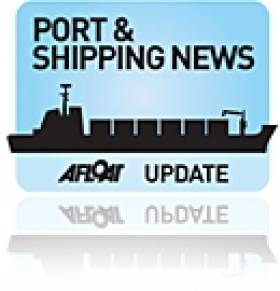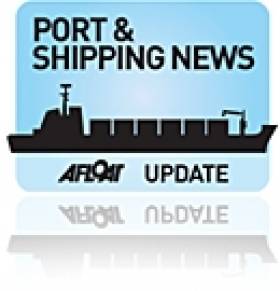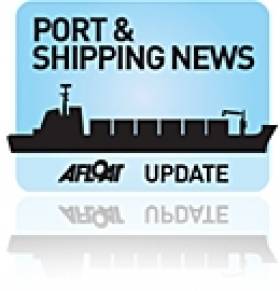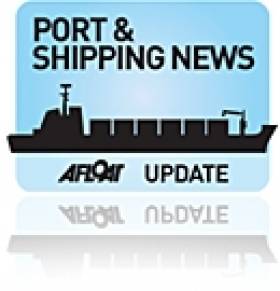Displaying items by tag: Port and Shipping News
#PortofWaterford – A port snapshot of shipping activity on Waterford Estuary this morning revealed an eclectic range of vessels between the city-centre quays to the open sea, writes Jehan Ashmore.
Departing the city where a pair of Royal Navy 'Archer' class fast-patrol cadet training boats, HMS Pursuer (P273) led by HMS Charger (P292). The sisters had visited the 100-berth Waterford City Marina on the historic quays providing easy access to visitors to Ireland's oldest city established by the Vikings.
As the naval pair departed downstream off The Island (Waterford Castle Hotel) they met the inbound Katrion, a 38m long luxurious motoryacht. The 10-guest capacity vessel built by Dutch yard Feadship had visited Glengariff as reported and subsequently Kinsale.
She completed her passage to moor at Merchants Quay along the city's mile long quay, described by the eminent architectural historian, Mark Girouard, as "the noblest quay in Europe".
Larger vessels such as Atlantic M a livestock-carrier is docked at Belview Container Terminal, the main port of Waterford. She trades to Libya along with sister Express 1 which as previously reported was detained in the UK earlier this year.
The Port of Waterford offers an inter-modal connection at Belview as Irish Rail (Iarnród Éireann) freight-trains from Ballina, Co. Mayo make an onward link to northern Europe through 'liner' shipping services operated by DFDS Logistics to Rotterdam.
The rail-sea service was re-launched in early 2013 and a year later the inter-modal service has been hailed a success according to Irish Rail.
To maintain sufficient depths the port has contracted the WD Mersey which is carrying out dredging work off Cheekpoint where the confluence is of the rivers Suir and Nore.The dredged spoil is disposed further downriver offshore of Dunmore East.
Wind Surf, a four-masted cruiseship is scheduled to call by anchoring in the harbour mouth offshore of Dunmore East on 11 July.
#LegenderryPort160 – Following another successful Legenderry Maritime Festival which culminated with a send-off farewell of Clipper Race yachts at the Parade of Sail on Sunday, the host port also celebrated their 160th anniversary.
Bonnie Anley, the new chairman of Londonderry Port and Harbour Commissioners commented on her delight having joined the commissioners in their 160th year. "In 1854, the Londonderry Port and Harbour Commissioners were set up to address the challenges facing a port city which wanted to expand its trading connections".
She added, "Over the past 160 years the port has played a vital role in the life of the city, from transatlantic trade and emigration, to WWII and the modern era.
The north-west port in the present day is a major economic driver for the region and handle over £1 billion worth of commodities per annum, with over 1000 associated jobs.
In 2013, the port had a a record year, with an increase of 27% in shipping. Furthermore, the port which is mostly centred at Lisahally on the east side of Lough Foyle, has acted as a hub for developing industries such as the renewable energy sector.
"We also play a key role in the development of marine leisure and cruise tourism, berthing cruise liners at Lisahally and Greencastle and running Foyle Port Marina to attract sailing and boating crews to the city".
"Providing the marine expertise to manage the arrival and departure of the Clipper Race fleet is a big part of this, and we've just finished a 40 metre extension to the Marina"
It's fantastic that the Foyle is attracting such high profile marine activity", concluded Chairman Bonnie Anley.
The commissioners are the Conservancy Authority for Lough Foyle between the harbour limits from Craigavon Bridge in the city to a line between Magilligan Point and Greencastle in Co. Donegal.
Between these locations is also where a car-ferry service is operated by the Lough Foyle Ferry Company.
IMDO Shipping Review: 24,000TEU On the Horizon, US Approve Oil Exports, Irish Motor Sales Drive Growth and much more
#Ports&Shipping –The latest IMDO Weekly Shipping Market Review includes the following stories as detailed below.
Container Market: 24,000 TEU containership on the horizon - Work on building a 24,000 TEU containership–5,000 TEU bigger than the current largest vessel–is set to begin in just two years time, according to a leading maritime consultant. Seatrade Global reported that technical feasibility studies have been concluded and show that at-sea costs for a 24,000 TEU vessel would be 23.1% lower versus a 12,500 TEU vessel and 17.4% lower versus a 16,000 TEU vessel.
Tanker Market: US approves limited unrefined oil exports - The administration of US President Barack Obama has approved the limited export of ultra-light crude oil (or oil condensates) for the first time in over forty years, TradeWinds reported. Two firms–Pioneer Natural Resources and Enterprise Product Partners– were given permission by the Department of Commerce to export minimally processed ultra-light crude, known as condensates, from shale oil deposits in Texas.
Irish Economy: Motor sales drive May retail growth - The volume of retail sales rose 0.9% month-on-month in May, while increasing 6.2% compared with May 2013 according to the latest figures from the Central Statistics Office (CSO). Motor sales proved the main factor in this expansion, rising 4.6% compared with April. Excluding motor sales, month-on-month volumes would have contracted 0.5% and on an annual basis, would only have risen 3.2%.
For more on each of the above and other stories click the PDF downloadable IMDO Weekly Markets Review (Week 26). In addition to coverage on Afloat.ie's dedicated Ports & Shipping News section.
Ship Scrubbers: Shipowners and Ports Call for Clarifications
#ShipScrubbers - The European Sustainable Shipping Forum) (ESSF) has called on European shipowners and port authorities urgently call for clarification of rules pertaining to use of scrubbers.
The EU Sulphur Directive is set to come into force in only a few months, on 01 January 2015. The new sulphur requirements impose that ships sailing in the SECAs (Sulphur Emission Control Areas-the Channel, the North Sea and the Baltic Sea) use bunker fuels with a sulphur content of maximum 0.1% or that the same level of emissions is reached by the use of alternative fuels or compliant abatement technologies.
Scrubbers have been identified as one of the few abatement technologies available allowing ships to reduce the sulphur content in their emissions. However, a lack of clarity in EU rules jeopardises their uptake. For further details ESPO has an update.
#GigaretteSeizedShips – This week's seizure of €14m in contraband cigarettes, the biggest haul in Europe so far this year from the M.V. Shingle in Drogheda Port and subsequent unloading in Dublin Port, echoes similarities to another major haul that took place a few years back.
The latest haul of 32m cigarettes including tobacco had been loaded in Slovenia on board the 667 tonnes Slovenia. However a considerably larger cargo of contraband totalling 120m cigarettes and worth €40m had taken place in 2009, then forming the largest ever cigarettes seizure to occur in the EU.
On that occasion, the larger 2,528 tonnes container-general cargoship M.V. Anne Scan had travelled much further to reach Ireland, having crossed the oceans from the Philippines.
The massive haul was carried out in another Co. Louth port, that been Greenore on Carlingford Lough. Likewise of the Shingle, she too was escorted by a Revenue Commissioners custom cutter, RCC Faire to Dublin Port where unloading took place also in Alexandra Basin.
The apprehending of both these vessels has potentially saved huge revenue otherwise lost at the expense of the Irish and UK exchequer.
Such high-profile hauls are a major coup for the multi-faceted agencies here in Ireland, the UK but also the EU's anti-fraud agency OLAF and global counterintelligence agencies.
In order to carry out such operations in Irish waters, this is where the Revenue Commissioners customs cutters have performed their role with co-operation of the Naval Service and the Gardai.
RCC Suirbheir an almost identical customs cutter of RCC Faire was also involved in the apprehending of the Shingle having also carried out escort duties on the passage between Drogheda and Dublin Port, from where the contraband was unloaded.
In addition further detailed technical examination was able to take place alongside Ocean Pier within Alexandra Basin west.
It would be the seizure of Anne Scan which saw the then brand new RCC Faire as mentioned above become involved in her first major task. She had only entered service for just over a week in late October 2009.
The Finnish built 23m cutter costing €2.6m was assisted by the Naval Service which deployed OPV L.E. Niamh (P52) to discreetly follow the transit of Anne Scan as she headed through the Irish Sea.
Her elder sister RCC Suirbheir was introduced in 2004 and she became the first custom-built vessel for the Revenue service since the foundation of the Irish Free State in 1922.
Capable of 25 knots, the cutters are equipped with an array of surveillance systems and use of a 38-knot RIB's to provide rapid response and added coverage as well to boarding vessels.
#Ports&ShippingReview: Over the last fortnight, Jehan Ashmore has reported on the shipping scene, where at the inaugural 'Our Ocean Wealth' Conference, Simon Coveney, Minister for the Marine outlined significant progress made implementing the Government's 2012 Harnessing Our Ocean Wealth: An Integrated Marine Plan for Ireland.
Arklow Beach is the third of six 'B' class 'green' newbuilds launched in the Netherlands for Arklow Shipping's Dutch subsidiary.
LD Lines finally resume their Ireland-Spain service via western France served by ro-pax Norman Atlantic, following an absence of more than three months.
Only days after L.E. Samuel Beckett's first patrol and major exercise, the vessel she directly replaced the Emer arrived off the Nigerian capital of Lagos to begin a new career in the oil industry.
Customs officers at Drogheda Port seize a ship loaded with €14m of cigarettes and tobacco, the biggest haul in Europe so far this year. The vessel, Shingle was later escorted by Revenue Customs Cutters RCC Suirbheir and RCC Faire to Dublin Port where the contraband cargo was unloaded.
Port Statistics for 2013 from the Central Statistics Office (CSO) reveal that Irish Ports handled more traffic when compared to 2012 where vessels numbers increased by 1.1% to 11,940.
#CSOportStats – Port Statistics for 2013 have been released from the Central Statistics Office (CSO) which show their analysis on Irish Ports which handled more traffic when compared to 2012.
The annual analysis also shows that the number of vessels arriving in Irish ports during 2013 increased by 1.1% to 11,940.
The routes between Dublin and three UK ports – Milford Haven (oil products only), Holyhead and Liverpool were the busiest routes for inward movement of goods in 2013. These accounted for nearly one quarter of the total weight of goods received. The Dublin-Liverpool and Dublin-Holyhead routes were also the busiest routes in terms of goods forwarded.
For much more in-depth analysis of the CSO figures, visit this LINK.
IMDO Shipping Review: 40ft Cubes to Dominate, Call for Fair Sulphur Enforcement, Irish Growth Broader-Based and much more
#Ports&Shipping –The latest IMDO Weekly Shipping Market Review includes the following stories as detailed below.
Container Market: 40ft high cubes to dominate market - High cube 40ft containers are soon expected to overtake conventional 40ft boxes as the main transport equipment in the maritime container fleet, according to Drewry Maritime Research's latest 'Container Census Report'. Figures show high cube boxes represented almost 50% of all containers in use at the close of 2013, growing 7% in the year–outpacing overall container fleet growth of 4.3%.
Regulation: Shipowners call for fair sulphur directive enforcement - Shipowner organisations have called on regulators to implement the upcoming European Sulphur Directive in a "harmonised and realistic" manner. The Directive–set to come into force on January 1st 2015 and which will require all ships in the Sulphur Emission Control Areas (SECAs) to reduce the sulphur content of their bunker fuel to a maximum 0.1%.
Irish Economy: Growth revival more broad-based - The Irish economy is expected to rebound strongly in 2014, with GDP growth of 2%, following a contraction of 0.3% in 2013. The latest EY Economic Eye report, produce by Ernst & Young, highlighted the emerging signs of recovery in domestic demand as one of the key positive trends. Domestic demand is expected to contribute positively to GDP growth this year for the first time since the onset of the financial crisis, with consumer sentiment, property prices and mortgage arrears already beginning to show signs of a stabilisation in the domestic economy.
For more on each of the above and other stories click the PDF downloadable IMDO Weekly Markets Review (Week 25). In addition to coverage on Afloat.ie's dedicated Ports & Shipping News section.
€14m Worth of Tobacco Seized on Ship at Drogheda Port
#TobaccoShipSeized – RTE reports that Customs officers at Drogheda Port have seized tobacco worth an estimated €14m.
Customs officers backed by gardaí boarded a ship in the early hours of yesterday morning and recovered 32 million cigarettes and 4,000kg of water pipe tobacco.
It is the biggest seizure of cigarettes in Europe this year.
The operation targeted an international crime gang led by Irish and UK nationals based in Europe.
The MV Shingle was loaded in Slovenia and arrived into Drogheda Port early this morning having sailed via Lisbon in Portugal.
The ship and its cargo were seized and a number of follow-up searches are under way both in Ireland and in mainland Europe.
A spokesperson for Revenue said the operation was the culmination of months of work by law enforcement agencies across the continent including Slovenia, Portugal and Ireland.
For more RTE has photos of the vessel departing Drogheda Port and arriving at Dublin Port plus TV news coverage by clicking HERE.
Afloat.ie adds the 669 tonnes built in 1982 was escorted from the Louth port to the capital by the Revenue Commissioners cutters RCC Suirbheir and RCC Faire.
Emer Arrives Ahead of Schedule off African Coast
#EmerAficanArrival -Only days after L.E. Samuel Beckett's completion of a first patrol and major exercise, the vessel she directly replaced the Emer arrived off the Nigerian capital of Lagos today, writes Jehan Ashmore.
As previously reported, she departed Cork Harbour for the final time on 7 June on a delivery voyage estimated to take three weeks. Therefore she took just over a fortnight to complete the journey as this morning she took anchorage off Lagos.
The former Naval Service OPV had undergone dry-docking in Cork Dockyard following her sale last year to Uniglobe International Services. She is to be placed on charter work serving the oil energy exploration sector where her primary role is to protect personnel when transferring technicians and workers to platforms.
As previously reported, one of her sisters L.E. Aoife took part in last week's naval manouvere off the south coast and the 1980 built vessel is understood to be decommissioned towards the end of this year.
Her direct replacement is the second 'Beckett' class, L.E. James Joyce due for delivery in the first quarter of 2015. At that stage, this will leave the sole 'Emer' class, L.E. Aisling in service though she too will be displaced by the third newbuild due to enter service in 2016.






































































